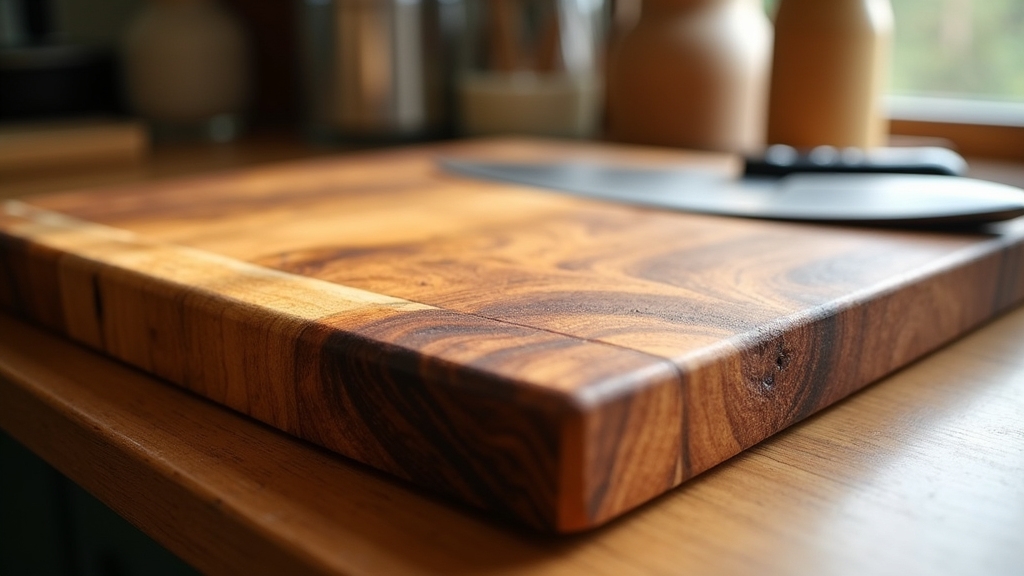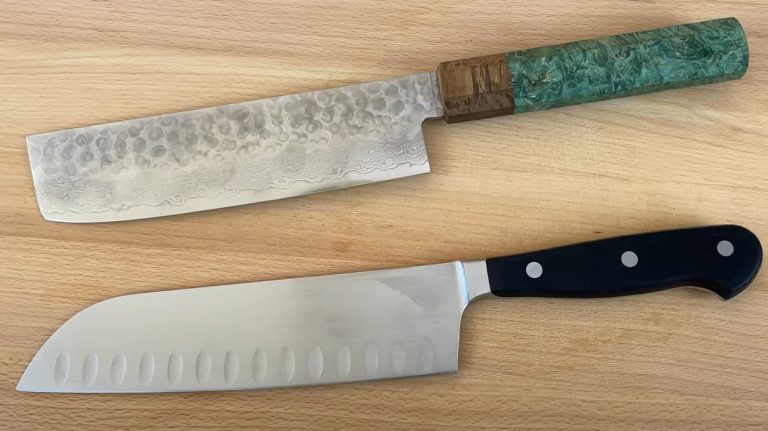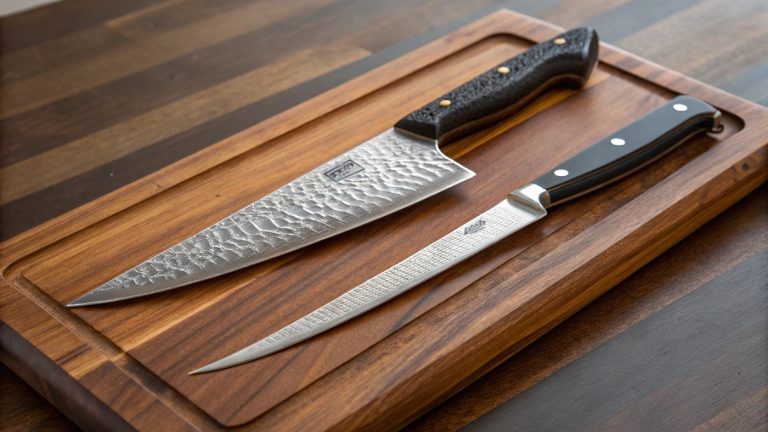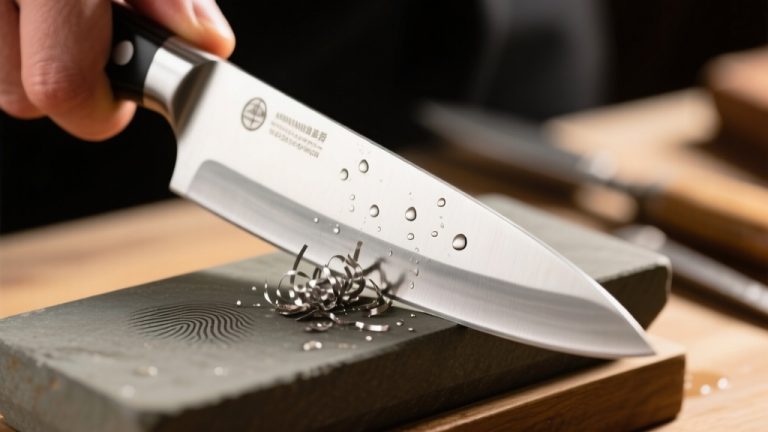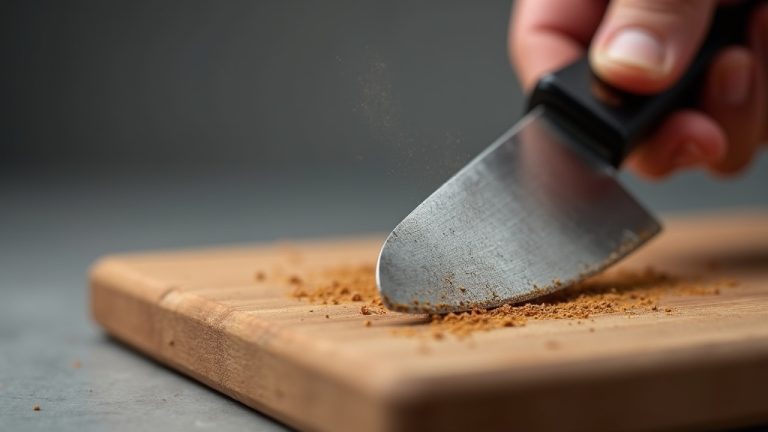Is Olive Wood Good for a Cutting Board? Find Out Now
You’ll find olive wood cutting boards highly durable and naturally antibacterial, thanks to its dense grain and natural oils that resist moisture and bacteria. Its hardness protects against warping but can dull knives faster, so regular sharpening is needed.
Olive wood also offers unique, attractive grain patterns that age beautifully. Proper care involves hand washing and periodic oiling to maintain hygiene and appearance.
If you want to optimize longevity and performance, it helps to understand handling and maintenance nuances.
Key Takeaways
- Olive wood is highly durable and dense, offering excellent resistance to scratches, dents, and warping for long-lasting cutting boards.
- Its natural antibacterial properties inhibit bacterial growth, making it hygienic and safe for food preparation.
- The wood’s distinctive swirling grain and warm tones provide a unique, attractive aesthetic that improves with age.
- Olive wood’s hardness causes knives to dull faster than softer woods, requiring more frequent sharpening and maintenance.
- Proper care includes hand washing, immediate drying, and regular oiling with food-safe oils to preserve its quality and antibacterial benefits.
Durability and Strength of Olive Wood Cutting Boards
Because olive wood is a hard and dense hardwood, it offers exceptional durability and strength for cutting boards. Its density surpasses that of oak and walnut, providing superior resistance to scratches, dents, and wear.
This hardness ensures your cutting board maintains structural integrity under heavy use, preventing warping or cracking. Its density also contributes to a higher hardness rating, similar to end grain boards, which enhances wear resistance.
The wood’s strength rivals teak, known for durability in demanding applications. Additionally, olive wood’s high density makes it non-porous, so deep cuts and grooves form less readily, enhancing longevity.
It also resists household chemicals and stains effectively, and its natural oils help prevent staining if cleaned promptly. Its natural antibacterial properties help prevent germ harboring, contributing to kitchen hygiene.
Compared to common hardwoods, olive wood cutting boards withstand impact and scratch damage better, and they don’t dull your knives easily, preserving both board and blade for extended use.
Natural Antibacterial Properties of Olive Wood
When you choose olive wood for a cutting board, you benefit from its inherent antibacterial properties derived from natural oils, polyphenols, tannins, and resins. These compounds inhibit bacterial growth and prevent microorganisms from penetrating deeply into the wood.
Olive wood’s dense, fine pore structure acts as a physical barrier, reducing surface imperfections where bacteria could accumulate. Studies confirm olive wood rapidly kills common kitchen bacteria like *E. coli* within minutes without chemical additives.
Research from the University of Wisconsin supports these findings, highlighting olive wood’s ability to kill germs efficiently due to its natural antibacterial properties. Additionally, maintaining cutting boards made from olive wood aligns with best practices for maintenance and care to ensure long-lasting hygiene.
Compared to plastic or bamboo, it resists moisture and cracking, limiting microbial harborage.
Proper maintenance—washing with mild soap, thorough drying, and periodic oiling—preserves these natural defenses.
This combination of chemical and structural properties ensures olive wood cutting boards maintain hygienic conditions, markedly reducing cross-contamination risks in food preparation environments.
How Olive Wood Affects Knife Sharpness?

Although olive wood offers excellent durability for cutting boards, its hardness considerably impacts knife sharpness. With a Janka rating around 3000, it’s much harder than typical cutting woods, causing knives to dull faster due to increased abrasion.
Unlike softer woods that provide blade “give,” olive wood’s dense surface limits edge compliance, accelerating metal abrasion and edge wear. While it resists deep cut grooves, preserving a smooth surface, the hardness still demands more frequent sharpening, especially for high Rockwell hardness knives prone to chipping.
Compared to bamboo or stone, olive wood is less abrasive but still tougher on blades than softer hardwoods like maple or walnut. Using olive wood means you’ll need to sharpen your knives more often to maintain ideal sharpness.
To prolong both the cutting board’s life and your knives’ edge, regular maintenance with food-grade mineral oil is recommended to condition and protect the wood.
Maintenance Tips for Olive Wood Cutting Boards
To preserve the durability and appearance of your olive wood cutting board, you must follow specific cleaning and conditioning routines. Always hand wash with mild detergent and warm water, avoiding dishwashers and soaking to prevent warping.
Use a soft sponge, not abrasive scrubbers, and dry immediately with a lint-free cloth before air drying upright. Proper cleaning prevents food contamination and preserves the board’s integrity by avoiding damage from hot water or hard pressure.
Monitoring humidity levels in storage areas can also help prevent moisture buildup that leads to wood damage and potential rust formation.
Condition the board regularly with food-safe mineral oil; reapply monthly or when dry. For enhanced protection, consider a mineral oil and beeswax blend. Avoid vegetable oils and harsh chemicals like bleach or baking soda, as they damage the wood.
Manage stains and odors with natural agents like lemon juice and salt. Store the board on its edge, away from extreme temperatures and sunlight. Light sanding before oiling can restore worn surfaces, ensuring long-term performance. This step helps to maintain the grain and extend the lifespan of your olive wood cutting board.
Unique Aesthetic Qualities of Olive Wood
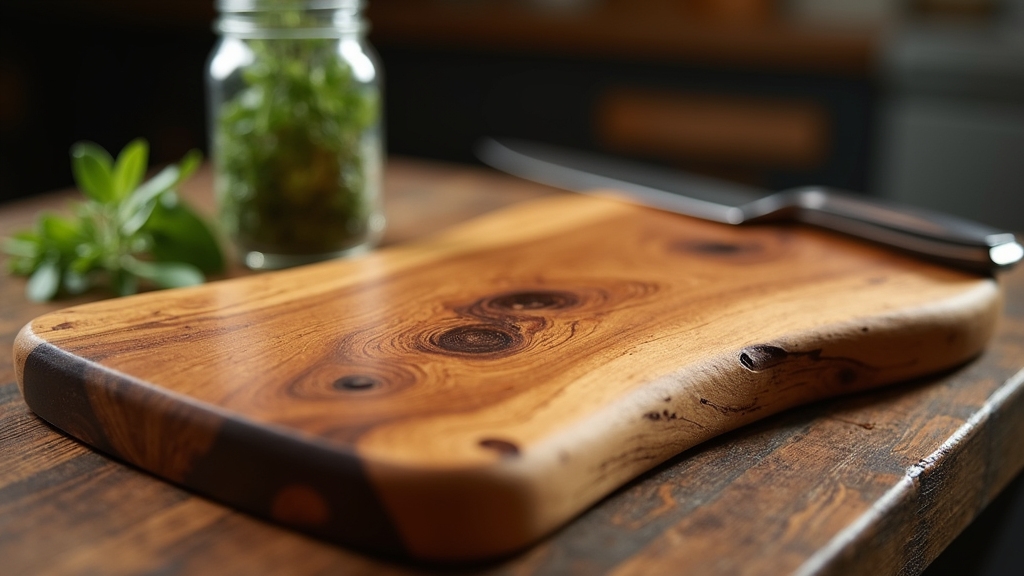
You’ll notice olive wood’s distinctive grain patterns, featuring swirling veins and contrasting dark streaks that make each board unique. Its warm color variations range from light yellow to deep amber, providing an earthy, inviting palette that complements many kitchen styles.
Over time, the wood’s natural aging process enhances its beauty, deepening the hues and enriching the overall visual appeal. Additionally, the wood’s exceptional durability ensures that this aesthetic appeal lasts for many years without warping or cracking. Olive wood also offers natural resistance to bacteria, making it a hygienic choice for kitchen use.
Distinctive Grain Patterns
How does olive wood’s grain pattern set it apart from other hardwoods used in cutting boards? Its intricate, swirling grains create a natural artistry unique to each board. This complexity results from centuries of growth in mature trees, producing varied textures and figures.
Swirling, burled patterns with knots add visual complexity. Contrast between dark and light streaks enhances depth. Grain lines range from tight to loose, reflecting growth rings. The wood’s natural oils also contribute to a subtle sheen, which helps protect the surface and enhances the wood’s durability.
Natural oils produce a subtle sheen, highlighting patterns. The wood’s origin from Italy and the slow growth cycle of olive trees contribute to the distinctive quality and craftsmanship.
Irregular grains demand skilled craftsmanship, ensuring uniqueness. When you choose olive wood, you get a cutting board that’s not only functional but also a dynamic, tactile work of art, with grain patterns that reveal their character over time.
Warm Color Variations
Beyond its distinctive grain patterns, olive wood captivates with a spectrum of warm color variations that enhance its appeal as a cutting board material. You’ll notice hues ranging from amber tones to vivid sunset shades, including honey brown, rich brown, and golden colors.
These warm colors create an inviting, natural aesthetic ideal for kitchen use. Olive wood is also highly durable, making it well-suited for enduring everyday cutting tasks. Its natural robustness is comparable to materials used in kitchen tools designed for frequent use.
Each board exhibits unique tonal contrasts and depth due to color intensity variations within the same piece, making no two boards identical.
Olive wood’s natural luminescence deepens and glows under natural light, adding a subtle sheen that enhances visual texture.
This combination of warm colors and natural sheen not only elevates the kitchen’s ambiance but also guarantees your cutting board remains a functional and decorative asset.
Aging Enhances Beauty
Although olive wood already boasts striking patterns and warm hues, its beauty intensifies with age through natural oxidation that deepens grain contrast and enriches visual texture.
As you use and care for your board, you’ll notice these unique aesthetic transformations:
- Grain patterns become more intricate and pronounced, enhancing artistic appeal.
- Color tonal shifts deepen warm ochres and dark browns, adding richness.
- A subtle patina develops, contributing rustic charm and character.
- Surface smoothness and sheen improve, yielding a silky, lustrous finish.
- A faint fruity aroma emerges, enhancing the sensory kitchen experience.
- The durability and maintenance of olive wood boards ensure they remain both practical and beautiful with continued use.
Additionally, the naturally antibacterial properties of olive wood help maintain its hygienic quality even as it ages, ensuring both beauty and functionality over time.
These changes not only elevate the board’s visual and tactile qualities but also reflect the wood’s natural lifecycle, making each olive wood cutting board a distinct, functional work of art.
Environmental Impact and Sustainability of Olive Wood
You’ll appreciate that olive wood cutting boards come from trees pruned or retired from fruit production, ensuring no healthy trees are felled solely for wood. This wood is a byproduct of longstanding Mediterranean farming traditions, highlighting its sustainable origins.
The manufacturing process minimizes waste by repurposing offcuts and often uses fossil-free energy, reducing carbon emissions. Regular maintenance and care can extend the life of olive wood products, making them a responsible choice for your kitchen. These sustainable harvesting and eco-friendly production methods make olive wood a responsible choice for your kitchen.
Sustainable Harvesting Practices
When you consider the sustainability of olive wood, its harvesting practices stand out for minimizing environmental impact. Olive wood primarily comes from old, non-productive trees and pruning residues, which means no healthy trees or forests are cut down. This repurposes old trees, giving them a second life through their wood.
This method supports continuous olive oil production while ensuring wood collection doesn’t disrupt ecosystems. Key factors include:
- Harvesting only dead or non-bearing trees and fallen branches
- Utilizing pruning waste and small offcuts to reduce material waste
- Maintaining orchard health by replanting younger trees after removal, which helps maintain long-term sustainability of the groves
- Preserving soil stability and biodiversity within olive groves
- Supporting carbon sequestration through long-lived tree retention
These practices collectively sustain environmental balance and promote a renewable resource cycle, making olive wood a responsible choice for cutting boards.
Eco-Friendly Production Methods
Because olive wood products often originate from retired or pruned trees, their production methods inherently support eco-friendly practices that minimize environmental impact. By utilizing wood from trees no longer bearing fruit, you reduce waste and avoid unnecessary deforestation, preserving biodiversity.
The durable wood acts as long-term carbon storage, offsetting greenhouse gas emissions. Manufacturing typically employs local artisan techniques that consume less energy than industrial methods, and many producers use renewable energy and eco-friendly packaging to lower the carbon footprint further.
Additionally, reusing olive wood biomass for by-products or fuel helps offset processing emissions. Compared to synthetic alternatives, olive wood’s biodegradability and natural antibacterial properties reduce environmental pollutants and chemical use, making it a sustainable, low-impact choice for cutting boards.
Versatility of Olive Wood in Kitchen Use
Although olive wood excels as a cutting surface due to its hardness and durability, its versatility extends well beyond basic food preparation. You’ll find olive wood ideal for multiple kitchen roles, combining function with aesthetic appeal.
Its distinctive grain and color make it suitable for serving and presentation, while its dense, smooth surface ensures hygienic food contact.
Unique grain patterns enhance visual appeal as serving platters. Natural antibacterial properties maintain food safety and contribute to overall kitchen hygiene. Dense yet knife-friendly surface preserves blade sharpness. Low porosity prevents odor absorption, aiding flavor neutrality. Durable and resistant to warping, supporting heavy, varied use.
Comparing Olive Wood to Other Hardwood Cutting Boards
While olive wood offers exceptional hardness and durability, it differs markedly from other hardwoods commonly used for cutting boards in ways that impact knife maintenance, longevity, and stability.
Its Janka hardness (~3000) far exceeds the ideal range (900-1500), causing knives to dull faster than on walnut (~1010), cherry (~995), or maple (~1450). These woods better balance durability and edge preservation.
Olive wood’s density grants superior scratch and dent resistance compared to oak, walnut, and cherry, but its grain is more prone to warping, especially since boards often come from single-piece blocks. Additionally, its high porosity can lead to increased absorption of liquids, which may foster bacterial growth if not properly maintained.
In contrast, maple and walnut feature tighter grains and greater dimensional stability.
Visually, olive wood’s swirling grain is unique, but its natural instability and hardness pose trade-offs you must consider alongside typical hardwoods for cutting board use.
Handling and Care to Prolong Olive Wood Board Lifespan
Maintaining olive wood cutting boards requires specific handling to preserve their unique hardness and visual appeal. You should hand wash them with mild soap and warm water, avoiding soaking or dishwashers that cause warping. Dry boards immediately and oil regularly with food-safe mineral or olive oil to maintain moisture and prevent cracking.
Hand wash olive wood boards with mild soap, dry immediately, and oil regularly to prevent warping and cracking.
Key care practices include:
- Use soft cloths or sponges for cleaning to protect the surface.
- Apply oil in circular motions; allow full absorption before use.
- Store boards upright in dry, ventilated areas away from sunlight.
- Avoid harsh chemicals; opt for natural cleaners like vinegar or lemon juice.
- Inspect for cracks regularly to address damage early.
- Never put olive wood products in the dishwasher to prevent damage.
Consistent maintenance sustains the board’s antibacterial properties, prevents warping, and enhances its longevity and appearance.
Where to Find Quality Olive Wood Cutting Boards?
When choosing a quality olive wood cutting board, you should consider both artisanal craftsmanship and sustainable sourcing to guarantee durability and aesthetic appeal.
Established brands like Oliviers & Co, Bérard, Montolivo, and Forest Decor offer boards crafted from solid, sustainably managed olive wood, emphasizing natural grain patterns and hardness. Additionally, complementing your kitchen setup with items such as Olivewood Salad Servers priced at $35.00 can enhance your dining experience.
You can find these products on specialized online retailers such as CuttingBoards.com, OliveWoodProducts.com, and The Oil Tap Online, which provide detailed specifications and guarantees.
For bulk purchases, consider wholesalers like Royal Olive Wood or Forest Decor’s wholesale program, which provide reliable, sustainably sourced options ideal for retailers and distributors.
Contacting Mediterranean producers directly also allows for custom orders tailored to your volume and design needs, ensuring authentic, high-quality olive wood cutting boards.
Frequently Asked Questions
Can Olive Wood Cutting Boards Be Used With Hot Pots or Pans?
You shouldn’t place hot pots or pans directly on olive wood cutting boards, as extreme heat can cause warping, cracking, or discoloration. Instead, use a trivet or heat pad to protect the wood.
Olive wood is heat-resistant but sensitive to sudden or intense heat exposure.
With proper care—like hand washing, drying promptly, and periodic oiling—you can maintain its durability and appearance while keeping it safe from heat damage.
Are Olive Wood Cutting Boards Safe for Dishwasher Cleaning?
Think of your olive wood cutting board as a delicate book—never toss it into a raging fire to clean its pages. You shouldn’t put it in the dishwasher; the high heat and water will warp and crack the wood.
Dishwashers strip away natural oils, dull the surface, and promote bacterial growth.
Instead, hand wash with mild soap, dry promptly, and oil regularly to maintain its durability and hygiene.
Do Olive Wood Cutting Boards Emit Any Natural Scent or Flavor?
Yes, olive wood cutting boards emit a mild, pleasant natural scent due to their inherent oils. You’ll notice a subtle aroma that generally won’t interfere with food flavors, as the scent is faint and non-intrusive.
These natural oils also prevent flavor transfer, maintaining your food’s integrity.
With proper care, including regular washing and periodic oiling, the scent remains gentle and doesn’t overpower or alter the taste of your ingredients.
How Heavy Are Typical Olive Wood Cutting Boards Compared to Others?
Typical olive wood cutting boards weigh between 5 to 8.2 pounds, depending on size and thickness. This makes them noticeably heavier than many other boards.
Compared to softer woods like Hinoki or common hardwoods such as maple and walnut, olive wood’s higher density and hardness lead to increased weight.
This heft provides stability during use but may reduce portability.
When choosing a board, consider how its weight aligns with your handling preferences and kitchen ergonomics.
Can Olive Wood Boards Be Personalized With Engravings or Logos?
Yes, you can personalize olive wood boards with engravings or logos. Laser engraving works best, providing precise, clean designs without damaging the wood’s surface.
The dense, durable grain enhances contrast and longevity of the customization. Just sand and oil the board before engraving, then apply food-safe oil afterward to protect and highlight the design.
Keep details moderate to avoid blurring, and typically engrave only one side to maintain a clean cutting surface.
Make Olive Wood Part of Your Sustainable Kitchen Today
Choosing olive wood for your cutting board combines durability with natural defense, delivering dependable, disease-deterring design. Its dense, distinctive grain guards your blades while granting graceful, glowing aesthetics to your kitchen.
By carefully cleaning, conditioning, and cutting on this sturdy surface, you’ll sustain its strength and sheen. Whether slicing, serving, or showcasing, olive wood stands as a smart, sustainable selection, seamlessly supporting your culinary skills with style and substance.

